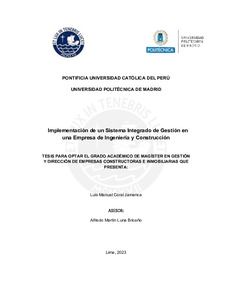| dc.contributor.advisor | Luna Briceño, Alfredo Martin | |
| dc.contributor.author | Coral Jamanca, Luis Manuel | |
| dc.date.accessioned | 2023-10-03T17:42:34Z | |
| dc.date.available | 2023-10-03T17:42:34Z | |
| dc.date.created | 2023 | |
| dc.date.issued | 2023-10-03 | |
| dc.identifier.uri | http://hdl.handle.net/20.500.12404/26073 | |
| dc.description.abstract | El sector de la industria de la construcción, específicamente en el Perú, es una de las actividades que gravitan en su crecimiento y desarrollo económico. Sin embargo, es también una fuente de enormes pérdidas para el Estado por factores que van desde una gran cantidad de proyectos inconclusos y paralizados con fuertes inversiones del erario nacional. Para contrarrestar esto es importante tener empresas constructoras calificadas que minimicen esas pérdidas para el Estado y para ellas mismas. Para eso planteamos como hipótesis que las empresas no solo deben tener certificaciones internacionales de sus procesos, sino que estas tienen que estar correlacionadas mediante un Sistema Integrado de Gestión (SIG) que permita una estricta interrelación de todos los procesos. Por ello partiendo de un diagnóstico estratégico de la empresa mediante el Análisis FODA, se constituyen los planes estratégicos a corto, mediano y largo plazo, para con eso establecer los procesos de aseguramiento de la calidad, de seguridad y salud ocupacional, que son certificados con las Normas ISO 9001:2015 y OHSSA 18001: 2007, respectivamente. Teniendo estas herramientas primero se establece la Política Integrada de la empresa y la definición del Alcance del Sistema Integrado de Gestión. Con eso se diseña el Mapa de Procesos con las correspondientes interrelaciones de calidad y seguridad y salud ocupacional, para que, en base a los procesos estratégicos, operativos y de soporte, se desarrollen los procedimientos, formatos, instructivos y cartillas, que son documentos que se requieren para hacer el seguimiento, control y la mejora continua del Sistema Integrado de Gestión. Finalmente, esto permite que todos los trabajadores se involucren en que nuestros proyectos tengan éxito y sepan que deben cumplir lo indicado en nuestro Mapa de Procesos, así como que todas estas labores deben tener la calidad requerida y velar por la seguridad y salud ocupacional de todos los trabajadores | es_ES |
| dc.description.abstract | The construction industry sector, specifically in Peru, is one of the activities that are important for its economic growth and development. However, it is also a source of enormous losses for the State due to factors ranging from a large number of unfinished and paralyzed projects with heavy investments from the national treasury. To counteract this, it is important to have qualified construction companies that minimize these losses for the State and for themselves. To this end, we propose as a hypothesis that companies should not only have international certifications of their processes, but that these must be correlated through an Integrated Management System (IMS) that allows a strict interrelation of all processes. Therefore, starting from a strategic diagnosis of the company through the SWOT Analysis, the short, medium and long term strategic plans are established, in order to establish the processes of quality assurance, safety and occupational health, which are certified with the ISO 9001:2015 and OHSSA 18001: 2007 Standards, respectively. Having these tools, the company's Integrated Policy and the definition of the Scope of the Integrated Management System are first established. With that, the Process Map is designed with the corresponding interrelationships of quality and occupational health and safety, so that, based on the strategic, operational and support processes, the procedures, formats, instructions and booklets are developed, which are documents required for monitoring, control and continuous improvement of the Integrated Management System. Finally, this allows all workers to be involved in the success of our projects and to know that they must comply with what is indicated in our Process Map, as well as that all these tasks must have the required quality and ensure the safety and occupational health of all workers | es_ES |
| dc.language.iso | spa | es_ES |
| dc.publisher | Pontificia Universidad Católica del Perú | es_ES |
| dc.rights | info:eu-repo/semantics/openAccess | es_ES |
| dc.rights.uri | http://creativecommons.org/licenses/by/2.5/pe/ | * |
| dc.subject | Calidad--Normas | es_ES |
| dc.subject | Sistemas de información gerencial | es_ES |
| dc.subject | Control de calidad--Normas | es_ES |
| dc.subject | Construcción--Proyectos--Control de calidad | es_ES |
| dc.title | Implementación de un Sistema Integrado de Gestión en una Empresa de Ingeniería y Construcción | es_ES |
| dc.type | info:eu-repo/semantics/masterThesis | es_ES |
| thesis.degree.name | Maestro en Gestión y Dirección de Empresas Constructoras e Inmobiliarias | es_ES |
| thesis.degree.level | Maestría | es_ES |
| thesis.degree.grantor | Pontificia Universidad Católica del Perú. Escuela de Posgrado | es_ES |
| thesis.degree.grantor | Universidad Politécnica de Madrid | es_ES |
| thesis.degree.discipline | Gestión y Dirección de Empresas Constructoras e Inmobiliarias | es_ES |
| renati.advisor.dni | 07243371 | |
| renati.advisor.orcid | https://orcid.org/0000-0002-7392-770X | es_ES |
| renati.author.dni | 31618255 | |
| renati.discipline | 732257 | es_ES |
| renati.juror | Ponce Durand, Cesar Arturo | es_ES |
| renati.juror | De La Torre Ugarte Cassinelli, Jose Andres | es_ES |
| renati.level | https://purl.org/pe-repo/renati/level#maestro | es_ES |
| renati.type | https://purl.org/pe-repo/renati/type#tesis | es_ES |
| dc.publisher.country | PE | es_ES |
| dc.subject.ocde | https://purl.org/pe-repo/ocde/ford#5.02.04 | es_ES |







